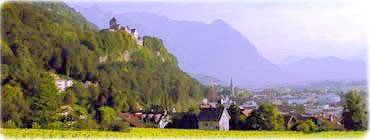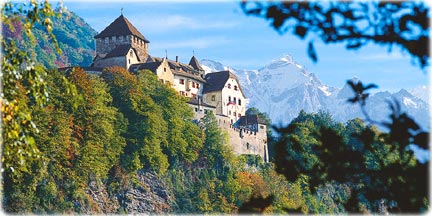
Liechtenstein
Liechtenstein is a landlocked country in Central Europe, under a constitutional monarchy. The capital is Vaduz.
The Principality of Liechtenstein (local: Fuerstentum Liechtenstein) was established within the Holy Roman Empire in 1719. It became a sovereign state in 1806. Until the end of World War I, it was closely tied to Austria, but the economic devastation caused by that conflict forced Liechtenstein to enter into a customs and monetary union with Switzerland. Since World War II (in which Liechtenstein remained neutral), the country's low taxes have spurred outstanding economic growth. More: Map of Liechtenstein ►

Geography
Administrative divisions: 11 communes (Gemeinden, singular - Gemeinde); Balzers, Eschen, Gamprin, Mauren, Planken, Ruggell, Schaan, Schellenberg, Triesen, Triesenberg, Vaduz.
Total area: 160 km².
Terrain: mostly mountainous (Alps) with Rhine Valley in western third. Highest point: Grauspitz 2,599 m (lowest point: Ruggeller Riet 430 m).
Climate: continental; cold, cloudy winters with frequent snow or rain; cool to moderately warm, cloudy, humid summers.
People
Population: 38,547 (2018).
Religions: Roman Catholic (official) 73.4%, Protestant Reformed 6.3%, Muslim 5.9%, Christian Orthodox 1.3%, Lutheran 1.2%, other Protestant .7%, other Christian .3%, other .8%, none 7%, unspecified 3.3% (2015 est.).
Ethnic groups: Liechtensteiner 66.2%, Swiss 9.6%, Austrian 5.8%, Italian 4.2%, German 3.1% other 11.2% (2016 est.).
Language: German 91.5% (official) (Alemannic is the main dialect), Italian 1.5%, Turkish 1.3%, Portuguese 1.1%, other 4.6% (2015 est.).
Main source: CIA - The World Factbook.
Vaduz Castle built in the 12th century, residence of the Princely Family since 1938 (photo www.liechtenstein.li).
Vaduz, the capital of Liechtenstein (photo www.liechtenstein.li).

|
Copyright © Geographic Guide - Travel European Continent. |
